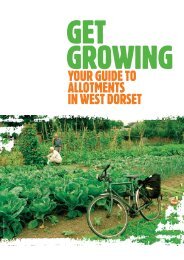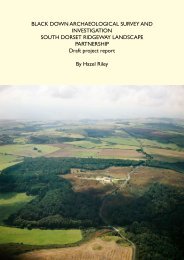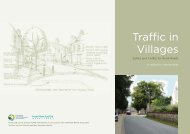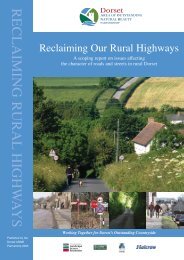Woodland Strategy 11.34 Mb - the Dorset AONB
Woodland Strategy 11.34 Mb - the Dorset AONB
Woodland Strategy 11.34 Mb - the Dorset AONB
You also want an ePaper? Increase the reach of your titles
YUMPU automatically turns print PDFs into web optimized ePapers that Google loves.
Section 7<br />
55<br />
Woods and forests have <strong>the</strong> potential to provide an excellent resource for tourism, physical<br />
activity and enjoyment of <strong>the</strong> countryside, and as a potential resource for learning and<br />
education for all ages. Walking <strong>the</strong> Way to Health, Active Woods and Space for People are<br />
recent initiatives aimed at understanding and promoting <strong>the</strong> use of woods for healthy living.<br />
There is an increasing need for people to learn and experience <strong>the</strong> natural world and<br />
understand <strong>the</strong> biodiversity around <strong>the</strong>m in order to encourage sustainable development.<br />
The Forest Education Initiative and <strong>the</strong> <strong>Woodland</strong> Trust’s ‘Trees For All’ campaign highlight<br />
<strong>the</strong> importance of connecting children and adults to <strong>the</strong> natural world.<br />
Tourism plays a major role in <strong>Dorset</strong> and could be an important source of revenue for<br />
woodlands. <strong>Dorset</strong>’s woods contain archaeological and cultural heritage sites and <strong>the</strong>re is<br />
also <strong>the</strong> opportunity to increase wood usage around existing tourist sites. There is potential<br />
within <strong>Dorset</strong> to develop woodlands as areas to visit to enhance <strong>the</strong> experiences of tourists<br />
that come from fur<strong>the</strong>r afield. People visiting one tourist attraction may well be encouraged<br />
to visit nearby woodland if it is well signposted and way-marked.<br />
Education<br />
Trees, whe<strong>the</strong>r individuals, veterans or grouped toge<strong>the</strong>r as woodlands and forests provide<br />
ideal formal and informal education and learning opportunities. Increasingly woodlands<br />
and forests are being used as outdoor classrooms, with activities linked to <strong>the</strong> National<br />
Curriculum, as well as for more informal education such as guided walks or forest trails. It is<br />
important that those who are not familiar with woodland management practices understand<br />
<strong>the</strong> processes and techniques used in order to ensure woodlands remain healthy, and all <strong>the</strong>ir<br />
associated species and habitats are sustained. Raising awareness, at all ages and levels, of<br />
woodlands and <strong>the</strong>ir value for biodiversity, local economies and rural employment engenders<br />
support and a sense of pride that supports <strong>the</strong> management of woodlands.<br />
Encouraging people to visit woodlands and interpreting what is happening, and why, is<br />
fundamental to <strong>the</strong>ir understanding of <strong>the</strong> reasons woodlands are managed and why <strong>the</strong><br />
woodlands of <strong>Dorset</strong> are such a valuable resource. Increased opportunities with appropriate<br />
access are to be encouraged for educational purpose and need not be detrimental to o<strong>the</strong>r<br />
woodland activities. Educating woodland users is essential.<br />
<strong>Woodland</strong> Ownership<br />
70% of <strong>the</strong> county woodland is in private ownership and 55% of <strong>the</strong>se are less than 100<br />
hectares. In <strong>the</strong> past many of <strong>the</strong>se woodlands were worked, producing quality timber,<br />
coppice products, and shooting. With <strong>the</strong> increase in imported timber and coppice products<br />
many woodlands are not managed as it is uneconomic to produce timber and associated<br />
products. With such a large proportion of <strong>Dorset</strong>’s woodlands owned and managed<br />
individually, <strong>the</strong> complexities of achieving a structured, sustainable approach to <strong>the</strong>ir<br />
management are increased. A co-ordinated, integrated approach to woodland management<br />
is essential to ensuring <strong>the</strong>ir continued survival and importance for biodiversity, as well as<br />
improving <strong>the</strong>ir economic value Engaging with woodland owners and understanding <strong>the</strong>ir<br />
motivations would enable a targeted approach through advice, training and grant aid.<br />
<strong>Woodland</strong> & Trees<br />
Local planning authorities should identify any areas of ancient woodland in <strong>the</strong>ir areas that<br />
do not have statutory protection (e.g. as a SSSI). They should not grant planning permission<br />
for any development that would result in its loss or deterioration unless <strong>the</strong> need for, and<br />
benefits of, <strong>the</strong> development in that location outweigh <strong>the</strong> loss of <strong>the</strong> woodland habitat.<br />
Aged or ‘veteran’ trees found outside ancient woodland are also particularly valuable for<br />
biodiversity and <strong>the</strong>ir loss should be avoided. Planning authorities should encourage <strong>the</strong><br />
conservation of such trees as part of development proposals.<br />
Through policies in plans, local authorities should also conserve o<strong>the</strong>r important natural<br />
habitat types that have been identified in <strong>the</strong> Countryside and Rights of Way Act 2000<br />
section 74 list, as being of principal importance for <strong>the</strong> conservation of biodiversity in<br />
England and identify opportunities to enhance and add to <strong>the</strong>m.<br />
Habitat Networks<br />
Local authorities should aim to maintain networks by avoiding or repairing <strong>the</strong><br />
fragmentation and isolation of natural habitats through policies in plans. Such networks<br />
should be protected from development, and, where possible, streng<strong>the</strong>ned by or integrated<br />
within it. This may be done as part of a wider strategy for <strong>the</strong> protection and extension of<br />
open space and access routes such as canals and rivers, including those within urban areas.<br />
Timber Production & Quality<br />
The cost effective production of timber is greatly determined by <strong>the</strong> economies of scale<br />
required. O<strong>the</strong>r than for <strong>the</strong> Forestry Commission and some of <strong>the</strong> larger private estates,<br />
cost effective production of timber is difficult to achieve, especially without financial aid such<br />
as <strong>the</strong> England <strong>Woodland</strong> Grant scheme. In recent years <strong>the</strong> timber market has been very<br />
poor, resulting in many woodland managers to delaying harvesting in <strong>the</strong> hope that <strong>the</strong><br />
market will improve. In 2006 timber prices improved and many owners have benefited.<br />
<strong>Woodland</strong> owners utilise <strong>the</strong> income from timber production to achieve o<strong>the</strong>r woodland<br />
orientated objectives, such as improved biodiversity, improved recreation opportunities and<br />
improved sporting opportunities. The decline in income has an obvious knock-on effect for<br />
<strong>the</strong> management of <strong>the</strong> forests and woodlands, and if <strong>the</strong> market does not pick up, or<br />
alternative outlet found, many areas will go un-harvested, resulting in a loss of income and<br />
possible fur<strong>the</strong>r losslack of sustainable management .












